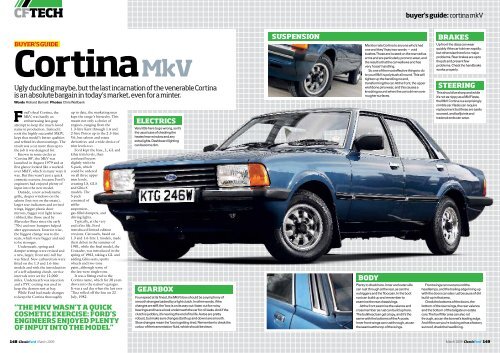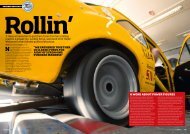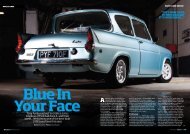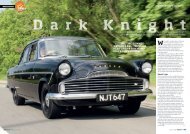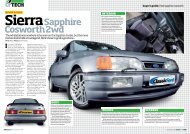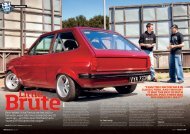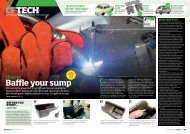Create successful ePaper yourself
Turn your PDF publications into a flip-book with our unique Google optimized e-Paper software.
cftechbuyer’s guide: cortina mkVBUYER’S GUIDECortina MkVUgly duckling maybe, but the last incarnation of the venerable Cortinais an absolute bargain in today’s market, even for a minter.Words Richard Barnett Photos Chris Wallbank<strong>Ford</strong>’s final Cortina, theMkV, was hardly anembarrassing last-gaspattempt to keep the much-lovedname in production. Instead ittook the highly successful MkIV,kept that model’s better qualitiesand refined its shortcomings. Theresult was a car more than up tothe job it was designed for.Known in some circles as‘Cortina 80’, the MkV waslaunched in August 1979 and atfirst glance looked like a workedoverMkIV, which in many ways itwas. But this wasn’t just a quickcosmetic exercise, because <strong>Ford</strong>’sengineers had enjoyed plenty ofinput into the new model.Outside, a new aerodynamicgrille, deeper windows on thesaloon (but not on the estate),larger rear indicators and revisedwings, bigger plastic doormirrors, bigger rear light lenses(ribbed, like those used byMercedes-Benz since the early’70s) and new bumpers helpedalter appearances. Interior-wise,the biggest change was to theseats, which were bigger and saidto be stronger.Underneath, spring anddamper settings were revised anda new, larger, front anti-roll barwas fitted. New carburettors werefitted on the 1.3 and 1.6-litremodels and with the introductionof a self-adjusting clutch, serviceintervals were set for 12,000miles. Underneath wax injectionand a PVC coating was used tokeep the demon rust at bay.While <strong>Ford</strong> had made changesto keep the Cortina thoroughlyup to date, the marketing menkept the range’s hierarchy. Thismeant not only a choice ofengines, ranging from the1.3-litre Kent through 1.6 and2-litre Pintos up to the 2.3-litreV6, but saloon and estatederivatives and a wide choice oftrim levels too.<strong>Ford</strong> kept the base, L, GL andGhia trim levels, thenconfused buyersslightly with theS-pack, whichcould be orderedon all three uppertrim levels,creating LS, GLSand Ghia Smodels. TheS-packconsisted ofstiffersuspension,gas-filled dampers, anddriving lights.Typically, at the veryend of its life, <strong>Ford</strong>introduced limited editionversions. Carousels, based on1.3 and 1.6-litre L models, madetheir debut in the summer of1981, while the final model, theCrusader, was introduced in thespring of 1982, taking a GL andadding Ghia seats, sportswheels and two-tonepaint, although some ofthe last were single tone.It was a fitting end to theCortina name, which for 20 yearsdrove into the nation’s garages.It was a sad day when the last ever’Tina rolled off the line on 22July, 1982.“the MkV wasn’t a quickcosmetic exercise: <strong>Ford</strong>’sengineers enjoyed plentyof input into the model”electricsVery little here to go wrong, so it’sthe usual case of checking theheated rear window and anyextra lights. Dashboard lightingcan become dim.GearboxFour-speed at its finest, the MkV’s box should be a symphony ofsmooth changes backed by a light clutch. In other words, if thechanges are stiff, the ’box is on its way out: listen out for noisybearings and have a look underneath the car for oil leaks. And if theclutch is juddery, it’s nearing the end of its life. Autos are prettyrobust, but make sure changes (both up and down) are smooth.Slow changes mean the ’box is getting tired. Remember to check thecolour of the transmission fluid, which should be clean.suspensionMention late Cortina to anyone who’s hadone and they’ll say two words — voidbushes. Those are located on the rear radiusarms and are particularly prone to wear, andthe result is that the car wallows and hasvery ‘loose’ handling.So one of the most effective things to doto your MkV is polybush all round. This willtighten up the handling no end,transforming the car. At the front, the upperwishbone pins wear, and this causes aknocking sound when the car is driven overrougher surfaces.BodyPlenty to check here. Inner and outer sillscan rust through at the rear, as can theoutriggers and the floorpan. In the bootrust can build up and remember toexamine the rear chassis legs.At the front examine the valance andcrossmember as rust can build up here.The bulkhead can get crispy, and it’s thesame with the bottoms of the A-posts.Inner front wings can rust through, as canthe seams at the top of the wings.BrakesUp front the discs can wearquickly if the car’s driven rapidly,but otherwise there’s no majorproblems. Rear brakes are up tothe job and present fewproblems. Check the handbrakeworks properly.steeringThis should be sharp and whileit’s not as nippy as a MkI Fiesta,the MkV Cortina is a surprisinglynimble car. Racks can requirereplacement but these are easilysourced, and balljoints andtrackrod ends can wear.Front wings can rust around theheadlamps, and the trailing edge lining upwith the doors can also rust because of dirtbuild-up in that area.Check the bottoms of the doors, thebottom of the rear wings, the rear valanceand the bottom of the tailgate on estatecars. The fuel filler area can also rotthrough, as can the bonnet’s leading edge.And if the car you’re looking at has a factorysunroof, check the headlining.148 March 2009March 2009 149
cftechbuyer’s guide: cortina mkVEngineIf you’re lucky enough to come across a1300, you might be tempted to throw theengine away and substitute it withsomething more powerful. If you want tokeep the engine, there are a few checksyou should carry out.Any smoke from the tailpipe, or out ofthe oil filler cap, is a sign the rings and/orthe bores are worn. Keep your ears opentoo, because a ticking noise means a camfollower could be broken. Make sure youchange the oil regularly.With the 1.6 and 2-litre Pinto units,premature camshaft wear is the maindownfall. This wear is caused by lack oflubricant through the spray bar.Camshaft followers can suffer as muchas the camshaft itself. Check the engineoil — if it’s dirty the engine could be on itslast legs as it will lead to theaforementioned camshaft wear. ThePinto will also need regular oil changes— every 5000-6000 miles or so.With the V6 unit, it’s important to checkfor both oil and coolant leaks. It’s alsoworth checking the coolant and the oilbecause of head gasket failure. Smokeout of the exhaust pipe indicates enginewear, as does valve gear rattle andgeneral rough running.ValuesGhias and limited editionCrusaders are the most valuableexamples, while Carousels aren’tworth more than normal models,although they enjoy a strongerfollowing than L models.£50-£400Rough examples, needingmasses of work, but possibly stilljust about running£400-£1200Cars that are not half bad, andrunning pretty well£1200-£2000Really nice examples£2000+Mint examples of V6 GhiasInteriorInteriors can wear, and seat fabricis especially vulnerable.Dashboard tops can crack anddoor cards can wear — findingsame-colour replacements canbe tricky. Carpet can wear and canalso become water-sodden as farback as the rear footwells if thebulkhead around the heatermatrix has rusted through.“It was a fitting end to theCortina name, which drove itselfinto the nation’s heart”insuranceFully comprehensive insurancecover for a 1980 Cortina GL valuedat £1500 is £371 per annum, basedon a 3000-mile limit and insured asa second car for a 26 year old with aKent postcode.Quote from <strong>Classic</strong> <strong>Ford</strong>Insurance, 0800 8119382 or www.classicfordinsurance.co.uk.need toknowClubs & ForumsBuySellCortinawww.buysellcortina.co.ukCortina Club Of Norwaywww.cortinaklubben.no/<strong>Ford</strong> Cortina OC (MkI-V)01253 356068www.cortina80.co.uk/<strong>Ford</strong> Cortina Club Of Ireland00353 2950991Swedish Cortina Club0046 520 481273www.cortinaklubben.nu/Specialists<strong>Classic</strong> <strong>Ford</strong> Parts01344 304064D&D Developments07789 066981www.danddevelopments.co.ukGoldendays01603 881155SpecBodySteel moncoque in two-doorsaloon, four-door saloon andfive-door estate forms.Engine1297cc pushrod ohv inline fourwith cast-iron head and blockand chain-driven camshaft,Motorcraft VV carburettor, 61bhp @ 6000 rpm.1593cc inline four Pinto unitwith cast-iron head and blockand belt-driven camshaft,Motorcraft VV carburettor(Weber 32/36 twin choke onGhia models), 75 bhp @ 5500rpm (92 bhp @ 5900 rpm onGhia models).1993cc inline four Pinto unitwith cast-iron head and blockand belt-driven camshaft,Motorcraft VV carburettor,102 bhp @ 5400 rpm.2294cc ‘Cologne’ V6 withcast-iron head and block andgear-driven camshaft, Solex35/35 EEIT carburettor, 116 bhp@ 5500 rpm.GearboxFour-speed all-synchromeshmanual or three-speedBorg-WarnerType 35automatic (not on 1.3-litre).SuspensionFront: independent, featuringcoil springs, wishbones andanti-roll bar.Rear: live axle featuring coilsprings, trailing and semitrailingradius arms andtelescopic dampers.SteeringRack and pinion (PAS standardon V6 models, optional on2-litre, not available on 1.3 and1.6-litre).BrakesFront: 9.75 inch discs.Rear: 9 inch drums.ThanksNextMonthSierra XR4x4Big thanks to Roger Chinneryat Affordable <strong>Classic</strong>s (www.affordableclassics.co.uk,01787 237887).150 March 2009 March 2009 151


